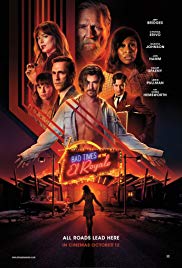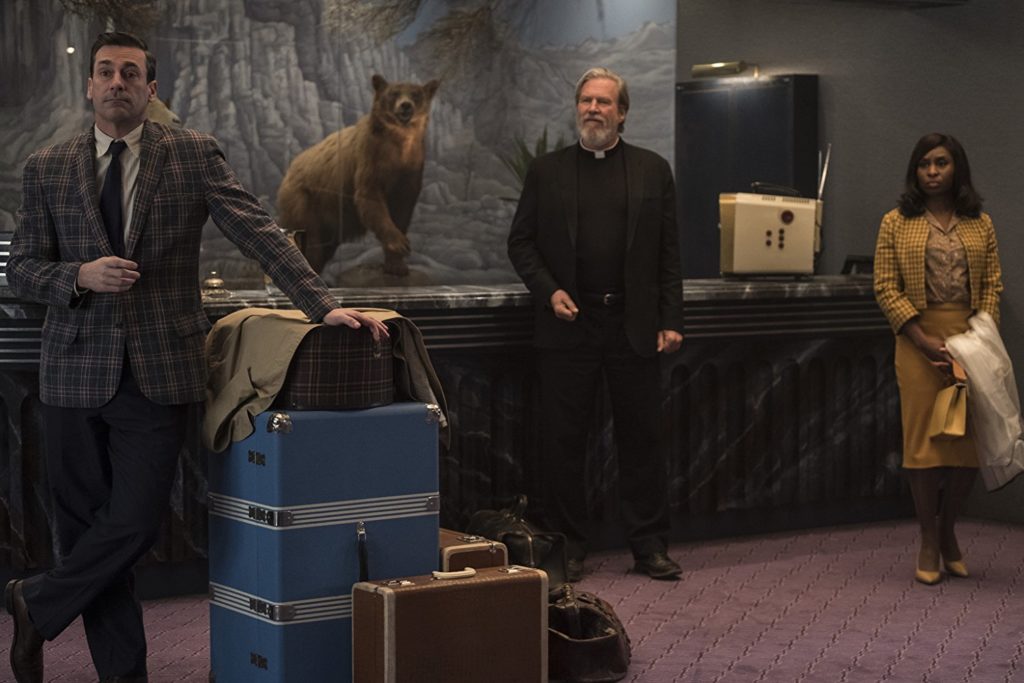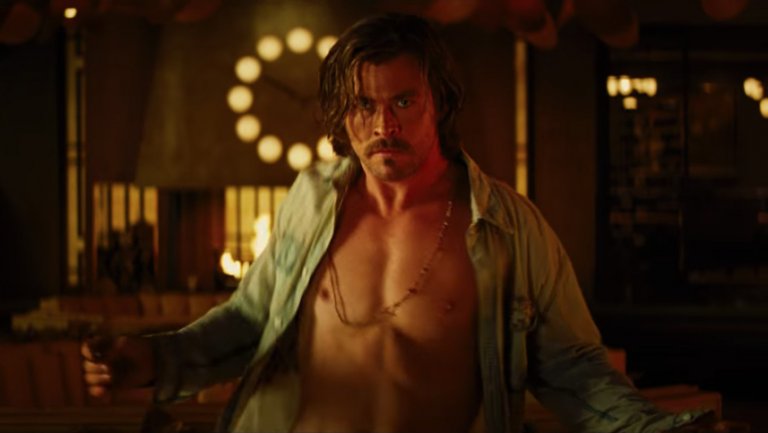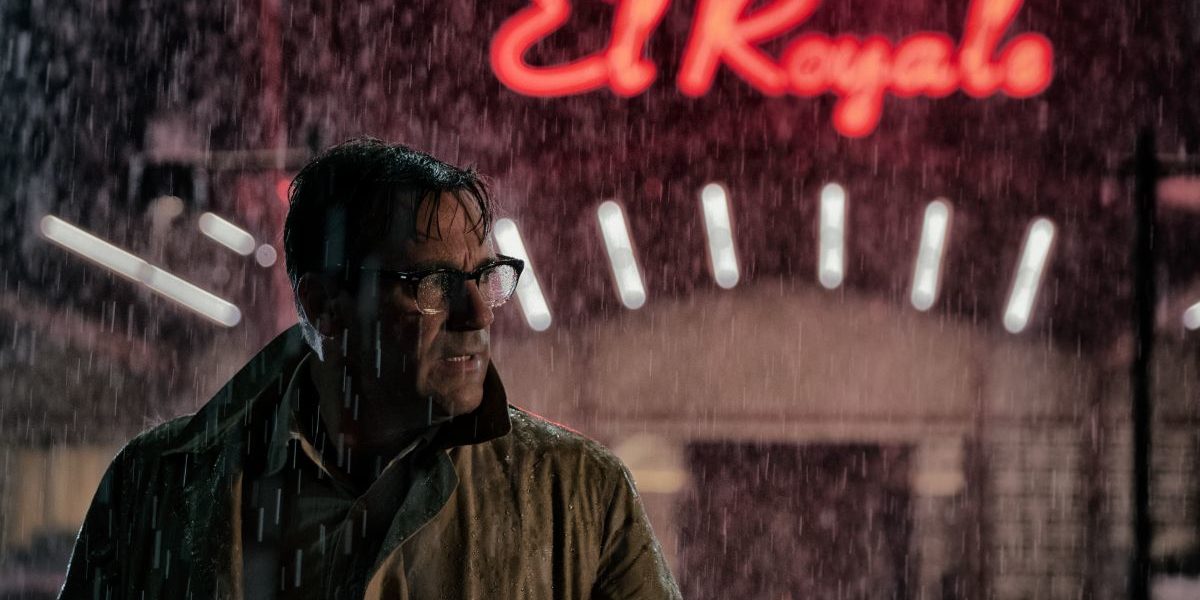You can Checkout any Time you Like, but you can Never Leave!
DIRECTED BY DREW GODDARD/2018
 The twisty new thriller Bad Times at the El Royale walks the line between being the best Quentin Tarantino knock off ever made, and the worst project that writer/director Drew Goddard has been involved with.
The twisty new thriller Bad Times at the El Royale walks the line between being the best Quentin Tarantino knock off ever made, and the worst project that writer/director Drew Goddard has been involved with.
It’s the early 1970’s or thereabouts, as four rascally vagabonds happen to converge on the titular hotel at same time. There’s Jeff Bridges in priest garb, going by name of Father Daniel Flynn. His character’s status as a man of the cloth is believable only to the others on screen; not so much to the audience. And even then, his little ruse only lasts so long. Yes, the old man has a secret- everyone in this movie pretty much does. But Flynn also suffers chronic memory loss. Why is he prying apart the floorboards of his room again…?
Although the central location of the forgotten El Royale hotel that straddles the California/Nevada border (with a thick red borderline painted down the center of the place) wears its fading retro charms well, the film bearing its name lacks underlying gravitas and even a central point. The character ensemble is an interesting batch, though arcs have tendencies to go nowhere, or wind up intentionally derailed. Goddard’s wild hairs within his rambling screenplay have potential as story ideas, but they shouldn’t be the only hook within this two-hour and twenty-one minute explosive amble.
After pleasantly meeting in the parking lot, Darlene Sweet, a singer of the Motown mold, strides in with Father Flynn. Tony Award winning performer Cynthia Erivo embodies the part to perfection, for what it’s worth. In a film that’s short on heart and soul, Bridges does what he can to bring the former while Erivo imbues the latter. Her singing moments, of which there are several, are outstanding. Simply put, Bad Times at the El Royale is lucky to have her.

Then there’s a cocksure FBI agent, played with scene-stealing swagger by John Hamm. Finally, a hippie girl in a very bad mood brushes passed all of them to check in. She’s played by the ever-underrated Dakota Johnson, sporting a lot of fringe, a scowl, and, for most of the rest of the film, a big gun. Soon, she’ll be spied in her room tying up a younger female prisoner, played by Cailee Spaeny.
All of them have to get passed the front desk clerk, Miles, played by Lewis Pullman. Miles is a bundle of nerves in a dopey bellhop uniform, and the only one working the entire hotel anymore. He’s not in charge, not by a long shot. But even at his young age, he’s seen and heard too much. And that’s before these mysterious scoundrels wandered into his life.
The opening sequences of the central characters meeting in the hotel lobby really is nothing but long-winded small talk monotony. Should we be intrigued by their casually revealed idiosyncrasies? Sure. But, when the information comes to us with all the charisma of a glass bottled IV drip, this vital period of hooking and reeling in we the viewers is woefully compromised. It’s almost as though Goddard, the tremendously accomplished screenwriter (dating back to some of the best episodes of Buffy the Vampire Slayer and Angel), decided he’d earned the opportunity to cast aside conventional wisdoms, and have himself a feature-length narrative experiment. He is gleefully batting around audience expectations with calculated abandon- the results occasionally playing as momentarily inspired- but all in all, there is, as they say, no “there” there.

Chris Hemsworth in BAD TIMES AT THE EL ROYALE.
Though the cool decor and blinking neon sign make for a great central location that time forgot, the story that unfolds amounts to little more than a stacked-up series of screenwriterly coincidences involving secret passages, two-way mirrors, drugged drinks, sabotaged car engines, and a reel of 8mm film with something that’s pretty incriminating to an unnamed famous person. Frustratingly, most of it amounts to concocted cleverness; macguffins purely for the sake of macguffins.
It plays out via Rashomon-esque flashbacks, the story folding in upon itself several times to reveal another aspect of a scene that played out twenty minutes prior. These moments strike one as nifty conceits worthy of a 2:00 AM film school dormatory brainstorming session. Eventually, Chris Hemsworth shows up as a Charles Manson wannabe cult leader, and takes over the movie. Because, why not? Also, this is when Bad Times truly sinks once and for all. There’s no resonance, there’s not even a central point to this only occasionally interesting screenwriting exercise.
By the looks of things, it appears that Drew Goddard has parlayed his accumulated acclaim and good will from having written The Martian and directing The Cabin in the Woods into making by his very own Tarantino rip-off. Even in the pre-release advertising, the influence of the Pulp Fiction director has been completely apparent. It’s a surprise then, that Pulp Fiction-era Tarantino isn’t the foundation Goddard has built Bad Times upon. The mid-nineties was truly lousy with hip cool-cats swaggering their way through crime, vibey tunes, and pop culture references. Though he popularized this, even Tarantino bailed on the formula by the time he made Kill Bill.

Dakota Johnson in BAD TIMES AT THE EL ROYALE.
It stands to reason, then, that by 2018, the long-passe notion of copping QT would need to have evolved similarly. With 2009’s Inglourious Basterds, Tarantino demonstrates his mastery of seemingly mundane chat scenes as tension ratcheters. In scene after scene, characters sit together talking until, ten or so minutes in, a wild and unforgettable burst of ten-second violence changes everything. This is the Tarantino that Goddard has chosen to emulate… sans the great dialogue. And again, it’s frustrating, since this too must’ve been a deliberate choice. Fans of Goddard’s work know that bland dialogue and lack of spark hasn’t been lacking, until now.
A word on the length of the film. Damien Chazelle’s First Man, opening in theaters the same day as Bad Times, is also two hours and twenty-one minutes. That film has the moon; this one merely has moonies. In Chazelle’s film, Neil Armstrong’s story spans a decade, the Earth, and the moon. It chronicles Armstrong’s walled-off inner self amid the emergence of the NASA space program, finally detailing history that everyone knows with humility and original vision. Bad Times can’t and won’t get out of the El Royale. If it’s meant to feel like a hellish eternity for the characters, it must be said that by the end, that comes through for the audience as well.
Bad Times at the El Royale is a talented screenwriter turned promising director mired in a very well dressed sophomore slump. Set-ups without payoffs and unexpected shifts in motivations and demeanor are the order of the day in Goddard’s tiring game of audience cat and mouse. Except, there is no room service in this place. To humanize and dehumanize characters at will is entirely within the creator’s purview. The payoffs to such switch-throwing can be refreshingly tremendous and tremendously refreshing, when successful. When less than successful… it can be Bad Times.


